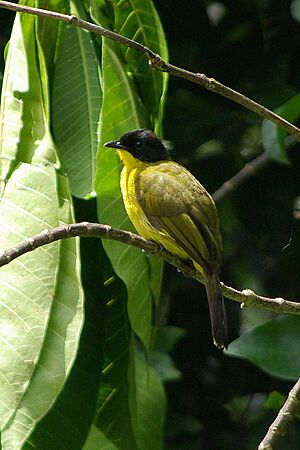Black-capped bulbul facts for kids
Quick facts for kids Black-capped bulbul |
|
|---|---|
 |
|
| Conservation status | |
| Scientific classification | |
| Synonyms | |
|
The black-capped bulbul (Rubigula melanictera) is a small, colorful bird from the bulbul family. It's also sometimes called the black-headed yellow bulbul. This special bird lives only in Sri Lanka, which means it is endemic to that country.
Contents
About the Black-Capped Bulbul
What's in a Name?
Scientists gave the black-capped bulbul its official name in 1789. A German naturalist named Johann Friedrich Gmelin first described it. He called it Muscicapa melanictera. The name melanictera comes from old Greek words. Melas means "black" and ikteros means "jaundice-yellow". This describes the bird's colors.
Over time, scientists learn more about how animals are related. They use new tools, like studying DNA. Because of this, the black-capped bulbul's scientific name changed. It used to be in the Pycnonotus group. But in 2017, a study showed it was better placed in the Rubigula group. This new name helps us understand its family tree better.
What Does It Look Like?
The black-capped bulbul is a pretty bird. It has a yellowish-green back and a bright yellow belly. Its head has a dark cap, and its throat is yellow. The tail is brownish and has a small white tip.
You can tell the difference between male and female birds by their eyes. Males have bright red eyes, while females have brown eyes. These birds also have a lovely song. They make sweet, soft whistling sounds and some sharper calls too.
Where Does It Live and What Does It Eat?
This bulbul loves living in forests and thick bushes. You can also find it in wooded areas and even in gardens in Sri Lanka. They usually fly around in pairs.
Black-capped bulbuls build their nests in bushes. A female bird usually lays two to four eggs at a time. They tend to breed between March and September. These birds enjoy eating both fruit and insects.
The Black-Capped Bulbul in Sri Lanka
In Sri Lanka, people have a special name for this bird. They call it Hisa kalu Kondaya. This means "black-headed bulbul" in the Sinhala language.



